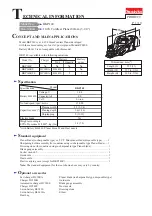
g0689 13" planer
-19-
Pitch & Glue Build-up
Problem: glue and resin buildup on the roll-
ers and cutterhead will cause overheating by
decreasing cutting sharpness while increasing
drag in the feed mechanism. the result can
include scorched lumber as well as uneven knife
marks and chatter.
Solution: Clean the rollers and cutterhead.
Chip Marks or Indentations
Problem: Chip indentation or chip bruising is the
result of wood chips not being thrown away from
the cutterhead and out of the machine. instead
they are carried around the cutterhead, deposited
on the planed surface and crushed by the outfeed
roller. Chip indentations can be caused by a num-
ber of reasons, some of which are:
•
the type of lumber being planed. Certain
species have a tendency to chip bruise.
•
a high moisture content (over 20%) or sur-
face moisture. typically found in air-dried
stock where the surface is dry but the inside
needs a longer time to season.
•
dull knives.
•
too much material being removed in one
pass.
•
dust bag is full.
Solution:
•
lumber must be completely dry, preferably
kiln-dried (Kd). air-dried (ad) lumber must
be seasoned properly and have no surface
moisture. do not surface partially-air-dried
(pad) lumber.
•
Make sure planer knives are sharp.
•
reduce depth-of-cut.
•
Empty dust bag.
Wood
Characteristics
Below is a list of wood characteristics you may
encounter when planing. the following descrip-
tions of defects will give you some possible
answers to problems you may encounter while
planing different materials. possible solutions fol-
low the descriptions.
Chipped Grain
Problem: usually a result of cutting against the
grain, planing lumber with knots or excessive
amount of cross grain, or using dull knives.
Solution: decrease the depth-of-cut. inspect
your lumber and determine if its grain pattern is
causing the problem. if the lumber does not show
substantial crossgrain, inspect your knives.
fuzzy Grain
Problem: usually caused by surfacing lumber
with too high of a moisture content. Sometimes
fuzzy grain is an unavoidable characteristic of
some woods, such as basswood. Fuzzy grain can
also be caused by dull knives.
Solution: Check the lumber with a moisture
meter. if moisture is greater than 20%, sticker the
lumber and allow it to dry. otherwise, inspect the
knife condition.
Snipe
Problem: occurs when board ends have more
material removed than the rest of the board.
usually caused when the workpiece is not prop-
erly supported as it goes through the machine. in
many cases, however, a small amount of snipe is
inevitable.
Solution: the best way to deal with snipe is by
planing lumber longer than your intended work
length and then cutting off the excess after plan-
ing is completed.
















































